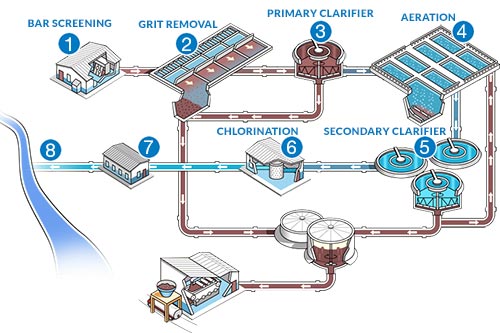Cost-Effective and Green Wastewater Treatment Solutions Near You
Cost-Effective and Green Wastewater Treatment Solutions Near You
Blog Article
Comprehending Wastewater Therapy Processes and Their Environmental Influence
The intricacies of wastewater treatment processes play a pivotal role in mitigating environmental difficulties connected with water contamination. Each stage, from preliminary to sophisticated treatments, is developed to deal with certain impurities, inevitably protecting both public health and wellness and water ecological communities.
Summary of Wastewater Therapy
Just how is wastewater changed into a secure resource for the setting? Wastewater therapy is a crucial process made to eliminate pollutants from used water, therefore guarding public health and wellness and safeguarding communities. This procedure begins with the collection of wastewater from residential, commercial, and industrial resources, which is then directed to therapy facilities.
At these facilities, numerous physical, chemical, and organic techniques are used to deal with the wastewater. Subsequently, biological treatments, such as triggered sludge processes, make use of microbes to damage down natural issue.
The treated effluent can be securely discharged right into natural water bodies or recycled for irrigation and commercial purposes, advertising resource preservation. Additionally, the therapy process produces biosolids, which can be repurposed as plant foods or dirt changes, better enhancing sustainability.
Phases of Treatment Procedures
The wastewater therapy process usually includes 3 primary phases: preliminary, key, and additional therapy. Each stage offers a distinctive role in minimizing the pollutant lots and making certain the effluent satisfies ecological standards before discharge.

The primary therapy phase concentrates on the physical splitting up of put on hold solids from the wastewater. Through sedimentation, heavier particles clear up at the end of sedimentation containers, forming sludge, while lighter products, such as oils and oils, float to the surface area and are skimmed off. This procedure dramatically decreases the organic and inorganic lots in the wastewater.
Additional treatment is an organic procedure aimed at additional lowering the focus of raw material. Different techniques, including activated sludge systems and flowing filters, make use of microbes to metabolize organic contaminants. This phase is essential for achieving the necessary biochemical oxygen need (FIGURE) reduction, eventually leading to cleaner effluent ready for discharge or further therapy. Each phase is vital in securing environmental and public wellness.

Advanced Treatment Technologies
Adhering to the additional treatment procedures, progressed treatment innovations play a vital role in more boosting the top quality of dealt with wastewater. These innovations are made to eliminate recurring contaminants that are not successfully eliminated during key and secondary therapies, guaranteeing the effluent fulfills stringent governing standards.
Among the extensively used advanced treatment approaches are membrane filtering, reverse osmosis, and progressed oxidation processes. Membrane purification, including microfiltration and ultrafiltration, works in separating fine fragments, pathogens, and colloids from the water (Wastewater). Reverse osmosis uses semi-permeable membrane layers to remove liquified solids, causing premium water ideal for various applications
Advanced oxidation processes (AOPs) utilize solid oxidants to degrade organic toxins, including pharmaceuticals and individual care products that are immune to standard therapy. These methods improve the biodegradability of complicated substances, promoting their elimination.
Another significant technology is making use of organic nutrient removal processes, which particularly target nitrogen and phosphorus, preventing eutrophication in receiving water bodies. Generally, innovative therapy technologies are necessary for achieving higher levels of filtration, advertising water reuse, and guarding public health while dealing with the difficulties related to wastewater management.
Environmental Benefits of Treatment
Various environmental benefits occur from efficient wastewater treatment processes that add to ecosystem health and sustainability. Mostly, these processes substantially reduce the release of dangerous toxins right into all-natural water bodies, which helps preserve marine ecosystems. By removing contaminants such as hefty metals, nutrients, and pathogens, dealt with wastewater reduces the risk of waterborne conditions and promotes biodiversity in marine settings.
Furthermore, wastewater treatment centers typically employ innovative technologies that allow water recycling and reuse. This practice not just saves fresh water resources yet likewise reduces the need on natural water products. Enhanced nutrient elimination from wastewater can likewise protect against eutrophication, a process that leads to algal blossoms and subsequent oxygen exhaustion in aquatic systems.
Furthermore, effective therapy processes can lessen greenhouse gas emissions, especially methane and laughing gas, which are typically released during untreated wastewater decay. By capturing and using this biogas from anaerobic digesters, centers can convert waste right into renewable resource, therefore contributing to a reduction in fossil gas dependency.
Difficulties and Future Fads
While the environmental benefits of wastewater therapy are clear, numerous challenges linger that hinder ideal results in this area. One major issue is aging framework, which often causes inadequacies and increased operational expenses - Wastewater. Lots of therapy plants were designed decades back, and their capacities do not straighten with modern needs, that include more stringent governing standards and higher quantities of wastewater resource as a result of urbanization

Looking ahead, there is a growing focus on source healing and circular economy concepts within wastewater therapy. Developments such as anaerobic digestion, which can create biogas, and advanced filtering innovations are acquiring traction. These techniques not only enhance treatment efficiency yet additionally advertise sustainability.
Eventually, dealing with these challenges calls for cooperation among stakeholders, financial investment in modern technology, and a dedication to recurring research study. By embracing these fads, the wastewater therapy market can develop to fulfill the needs of an altering atmosphere and society.
Verdict
In final thought, wastewater therapy procedures play an essential duty in enhancing environmental quality and public health. The multi-stage treatment framework, combined with sophisticated click to investigate innovations, successfully minimizes air pollution and advertises lasting water monitoring.
Report this page